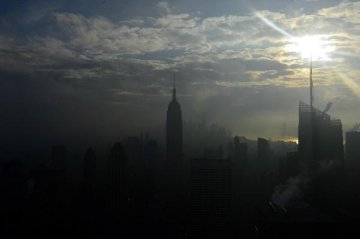
Report paints a generally positive picture for the U.S. economy, but with an undercurrent of worry
The shadow of a worker fell on a fence at the construction site of a convenience store in Victorville, Calif. The Fed’s beige book said residential and commercial builders in the Philadelphia region were beginning to scramble for new projects.
Optimism is waning among U.S. businesses as they grapple with the government shutdown, trade disputes, higher borrowing costs and a volatile stock market.
Although the economy continues to grow at a modest to moderate pace, some firms are pulling back on planned investments and paring back their 2019 forecasts, according to a Federal Reserve report released Wednesday.
The report, known as the beige book, compiles information from business contacts in each of the central bank’s 12 districts through Jan. 7.
With the usual flow of economic data constricted by the partial government shutdown, the anecdotes compiled in the beige book will be carefully scrutinized by investors and Fed officials looking for signs of slowing growth.
The report paints a generally positive picture for the U.S. economy but reveals an undercurrent of worry that Fed officials will take into account as they gather for their next meeting, Jan. 29-30. Over the past few weeks, officials have said they aren’t in any hurry to raise interest rates again as they assess how the U.S. responds to slowing global growth, fears of a trade war, recent stock market fluctuations and the government shutdown.
The Fed last raised rates in December to a range of between 2.25% and 2.5%, the fourth increase of 2018.
“Outlooks generally remained positive, but many districts reported that contacts had become less optimistic in response to increased financial market volatility, rising short-term interest rates, falling energy prices and elevated trade and political uncertainty,” the report said.
Bankers in the Philadelphia region said that although the economy remained strong, their clients were “’jittery’ due to economic uncertainty.” Residential and commercial builders there also said they “were beginning to scramble for new projects to keep their workers employed.”
Many of the firms contacted for the report said they were struggling with higher input prices, in part due to tariffs. In Maryland, a can manufacturer reported looking for ways to increase automation to offset the cost of raw materials. A Virginia manufacturer of trophy cases also had Chinese goods shipped to West Coast ports to beat an expected tariff increase. In some cases, firms said they were hesitant to pass higher input costs onto their customers, preferring to absorb lower margins instead.
In New York, retailers said holiday sales “were a bit on the sluggish side but still up from a year ago.”
Firms also said they were continuing to have a hard time recruiting workers, leading them to raise wages, particularly for entry-level workers. Energy companies also put off capital expenditures in response to lower energy prices, the report said.
The partial government shutdown, now in its fourth week, had also delayed the release of government agricultural data, “leading to greater uncertainty for market participants” in the Chicago region. A round of payments from the federal government’s Market Facilitation Program was also disrupted by the shutdown.
“We have private sector actors that are seeing a slowdown, a shift in momentum, but overall we’re not in a recessionary environment,” said Gregory Daco, chief U.S. economist at Oxford Economics.
The beige book follows other signs of cooling momentum in the first few months of the year. Measures of manufacturing and service-sector activity slowed sharply in December, according to the Institute for Supply Management.
In a conference call with analysts last month, Michael Happe, CEO of Winnebago Industries, Inc., a manufacturer of recreational vehicles, said the overall economic outlook was now “much choppier than in the past several years.”
“The impact of tariffs and material cost increases are real for most durable good businesses and have resulted in higher prices at retail on RVs and boats,” he said.
Delta Air Lines CEO Edward Bastian told analysts on a conference call Tuesday that the government shutdown was costing the airline $25 million a month in reduced government travel.
As the shutdown drags on with no end in sight, economists are starting to bring down their growth forecasts for the first quarter. White House economists estimate the economy loses 1/10th of a percentage point in growth every week the shutdown is in effect.
Continued uncertainty over trade and a slowdown in the global economy are also putting a damper on forecasts. Economists surveyed by The Wall Street Journal in early January pegged recession odds in the U.S. at 25%, the highest level since October 2011.
Source: The Wall Street Journal






















Latest comments